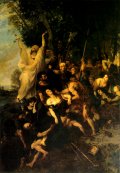The Boston Public Library
From
Charles F. McKim to Mr. Abbot, President of the Board of Trustees, Boston
Public Library, May 9th, 1890
The
Boston Public Library
From 57, BroadwayFootnotes
New York
May 9th, 1890McKim, Mead and White,
Architects
Charles F. McKim
Wm. Rutherford Mead
Stanford WhiteMy Dear Abbott,
Let me explain my despatch today I received one morning a little over a week ago an excited note from St. Gaudens, stating that Abbey had just returned from Boston and was at that moment dining with him. It appears that while there, Abbey had gone over the Library and was so impressed that on his return he could talk of nothing else. This at least was the substance of St. Gaudens's note.
It appeared also that Sargent had expressed himself strongly interested in it, and knowing the policy of your Board in favour of mural decoration should the opportunity offer for it, St. Gaudens proposed boldly that we should meet at "The Players" Club the following Wednesday evening and dine with him and talk over a scheme to be submitted to the Trustees. You can imagine how joyfully this news with such substantial assurances of interest and approval from men like Abbey and Sargent and St. Gaudens, and how delighted we were to accept his invitation to meet them for dinner. Only Abbey, Sargent, St. Gaudens and McKim, Mead & White were present. After dinner, the plans of the Library were spread out and the mural possibilities of the walls and ceilings of the halls and galleries forming the special library collections discussed. Abbey was vastly interested in the Shakespeare collection while Sargent's interest in the direction of Spanish literature was a most natural one. The interest of the occasion was much enhanced by the presence of several hundreds of carbon prints from the Masters, covering the whole period of the Renaissance. The works of Baudry[1] and Puvis de Chavannes[2] were also discussed.
Finally Abbey with the spontaneity which characterized him could resist no longer and seizing his pencil sketched out almost in a moment, upon a sheet of brown wrapping paper, which happened to be at hand, two compositions for the Shakespeare Room, representing at one end "Comedy" seated opposite "Tragedy" under a ceiling divided into "Sonnets." These two allegorical figures were placed in repose over the central door-ways of access and exit from the room and were surrounded each with numerous figures proper to the subject. It was impossible to restrain our admiration as he went from one thing to another. talking as he drew, and it was good to observe the pride which Sargent evinced in the powers of his brother-artist. The next day Abbey came here at four o'clock and stayed for two hours or more for the purpose of obtaining accurate measurements of the walls surface and ceiling to be covered, and the disposition of the various vaultings. I gave him three arrangements: one representing an assumed collection requiring a space the length of two windows, one representing the length of three windows, and one representing five windows in length. The last with a barrel vault (with square ends), the first two groined (with penetrations).
Last night I dined with him and his wife at St. Gaudens's and learned that he had actually made a study in oil since our meeting at "The Players" Club, which St. Gaudens and I are going to see today. To make a long story short, we propose if you approve, to descend upon you in Boston some time next week Wednesday, with the sketches which have been made at our request, and take dinner with you and talk this matter over.
Abbey sails immediately for Capri with his bride of two weeks. St. Gaudens and I are very anxious that you should meet and know him, hence the sudden dispatch. The suggestion to ask Mr. Brooks, Mr. Brimmer and others at the same time, was, in order to render the occasion more interesting, as well as to create, if possible, public support of a policy which has not been carried out on this side of the ocean. Of course we do not expect anything from the City, but I am convinced that any space which you may see fit to allot to Abbey and to Sargent be paid for privately. I already have some promising assurances of this!
No such brilliant opportunity has come within my recollection and I feel sure that it will appeal to you all in the way it deserves.
Sincerely yours,
Charles F. McKim
S.A.B. Abbott, Esq.
(Letter to Abbot, E. V. Lucas, "Life of Edwin Abbey," p. 28; quoated in Charteris; pp. 104-106)

The Torment of a Vestale 1848 |
Paul Baudry (1828-1886)
French Painter and muralist. He entered the school of arts at the age of sixteen. Within six years (1850) he won the Grand Prix de Rome at the Ecole des Beaux-Arts. Between 1865-1874 he became Napoleon III's favorite painter. He was commissioned to decorate public buildings such as the foyer of the de l'Opéra and was appointed to the jury of the Salon. It would be Baudry, amoung others, who railed against the new Impressionists painters (such as Manet et al), but would eventually find himself unconsciously influence by them (as most painters would be) towards the end of his career. He died in Paris in 1886. (Musée des Beaux-Arts de Bordeaux ) |
"His simplified forms, respect for
the flatness of the picture surface, rhythmic line, and use of non-naturalistic
color to evoke the mood of the painting appealed to both the Post-Impressionists
and the Symbolists."
(WebMuseum)